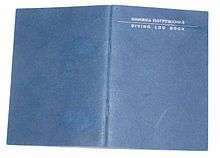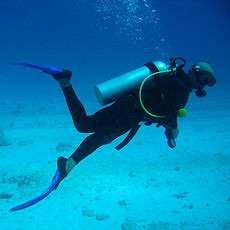Dive log

A dive log is used by an underwater diver to record the details of their dives. The log may either be in a book, software, or web based. The log serves purposes both related to safety and personal records. Information in a log may contains such things as date, time and location, the profile of the dive, equipment used, air usage, above and below water conditions, such as temperature, current, wind and waves, general comments, verification of buddy and instructor.
In case of a diving accident, it can provide valuable data regarding diver's previous experience, as well as the other factors that might have led to the accident itself. [1]
Recreational divers are generally advised to keep a logbook as a record, while professional divers may be legally obliged to maintain a logbook which is up to date and complete in its records. The professional diver's logbook is a legal document and may be important for getting employment. The required content and formatting of the professional diver's logbook is generally specified by the registration authority, but may also be specified by an industry association such as the International Marine Contractors Association (IMCA).
Contents of the logbook
Typical sections in a recreational diver's log book would be the following:
- Header - Contains basic information about the date, time and location of the dive.
- Profile - Records sufficient detail to show the profile of the dive.
- Equipment - Shows what the diver was wearing and what dive gear was used during the dive.
- Conditions - Allows the diver to record what the environment was like (both above and below water).
- Comments - Used for any general information not covered in other sections.
- Verification - used to record the signature and certification details of the buddy / instructor that was with the diver during the dive.
A commercial diver's logbook may be considered a legal document, and may contain more information, both about the diver, and about each dive recorded. It is generally verified by the diving supervisor for each diving operation.[2][3][4] It may include the following sections:[2][4]
- Personal details of the diver
- Medical certificates of fitness to dive and notes
- Qualifications and certificates
- Training record
- Competence assessment record
- Record of dives
- Medical records illness or injury
- Cumulative diving experience
The record of each dive may contain:[2][4]
- Date of the dive
- Signature of the diver
- Name and address of the diving contractor
- Dive location
- Vessel or installation from which the dive is done
- Type of dive (Surface oriented or saturation)
- For bell bounce or surface dives:
- Maximum depth of the dive
- Time left surface or started pressurisation
- Bottom time
- Time that decompression was completed
- Details of any surface decompression, including surface interval and time in the chamber
- Accumulated bottom time
- Accumulated total time under pressure
- For saturation dives:
- Storage depth
- Maximum depth of dive
- Bell lock-off time
- Time that diver left bell
- Time that diver returned to bell
- Lock-out duration
- Bell lock-on time
- Accumulated number of lock-outs
- Accumulated total time under pressure
- For bell bounce or surface dives:
- Details of work done and equipment used:
- Breathing apparatus used
- Breathing mixture used
- Work description, equipment and tools used
- Name of decompression schedules used
- Notes regarding any decompression incident or other illness or injury
- Any other relevant comments
- Name and signature of the diving supervisor for the dive
- Diving contractor's official company stamp
Dive log software
Usually diving computer manufactures have their own software to view and analyze diving logs, but there are also open source versions. Subsurface is free open source dive log software started by Linus Torvalds, which is compatible with several makes of downloadable diving computer.[5]
Sources
- ↑ http://www.rescuediver.org/med/diveact.htm
- 1 2 3 Diving Regulations 2009 of the South African Occupational Health and Safety Act, 1993. Government notice R41, Government Gazette #32907 of 29 January 2010, Government Printer, Pretoria
- ↑ Statutory Instruments 1997 No. 2776, HEALTH AND SAFETY, The Diving at Work Regulations 1997. http://www.legislation.gov.uk/uksi/1997/2776/introduction/made
- 1 2 3 Staff. "Professional diver's logbook". Retrieved 31 October 2016.
For completion in line with IMCA C 003 – Guidance on competence assurance & assessment - diving division, this logbook allows the user to record information on medical certificates/notes, qualifications/ certifications, training, competence, record of dives, record of medical illness and cumulative diving experience.
- ↑ https://github.com/torvalds/subsurface
